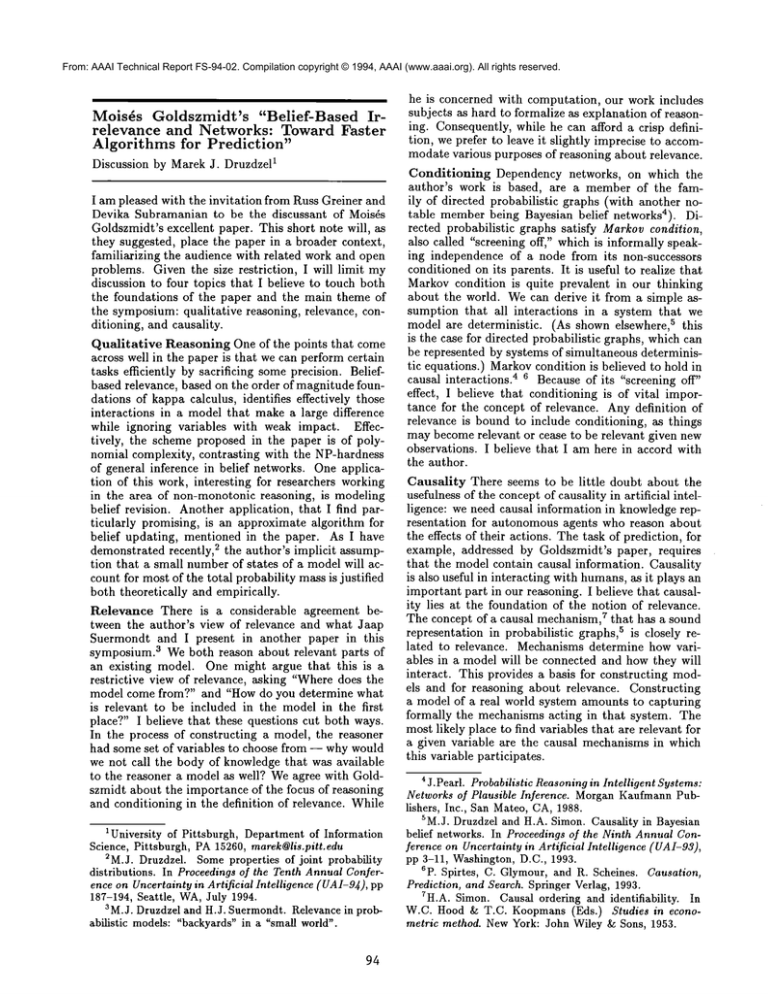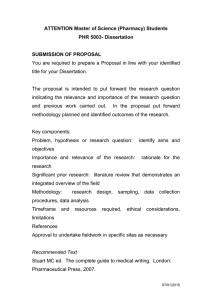
From: AAAI Technical Report FS-94-02. Compilation copyright © 1994, AAAI (www.aaai.org). All rights reserved.
Mois6s Goldszmidt’s
"Belief-Based
relevance
and Networks:
Toward
Algorithms
for Prediction"
1Discussion by Marek J. Druzdzel
IrFaster
I am pleased with the invitation from Russ Greiner and
Devika Subramanian to be the discussant of Moisds
Goldszmidt’s excellent paper. This short note will, as
they suggested, place the paper in a broader context,
familiarizing the audience with related work and open
problems. Given the size restriction, I will limit my
discussion to four topics that I believe to touch both
the foundations of the paper and the main theme of
the symposium:qualitative reasoning, relevance, conditioning, and causality.
Qualitative Reasoning One of the points that come
across well in the paper is that we can perform certain
tasks efficiently by sacrificing someprecision. Beliefbased relevance, based on the order of magnitude foundations of kappa calculus, identifies effectively those
interactions in a model that make a large difference
while ignoring variables with weak impact. Effectively, the scheme proposed in the paper is of polynomial complexity, contrasting with the NP-hardness
of general inference in belief networks. One application of this work, interesting for researchers working
in the area of non-monotonic reasoning, is modeling
belief revision. Another application, that I find particularly promising, is an approximate algorithm for
belief updating, mentioned in the paper. As I have
demonstrated recently, 2 the author’s implicit assumption that a small number of states of a model will account for most of the total probability massis justified
both theoretically and empirically.
Relevance There is a considerable agreement between the author’s view of relevance and what Jaap
Suermondt and I present in another paper in this
symposium.3 Weboth reason about relevant parts of
an existing model. One might argue that this is a
restrictive view of relevance, asking "Wheredoes the
model come from?" and "How do you determine what
is relevant to be included in the model in the first
place?" I believe that these questions cut both ways.
In the process of constructing a model, the reasoner
had some set of variables to choose from -- why would
we not call the body of knowledge that was available
to the reasoner a model as well? Weagree with Goldszmidt about the importance of the focus of reasoning
and conditioning in the definition of relevance. While
1University of Pittsburgh, Departmentof Information
Science, Pittsburgh, PA15260, marek@lis.pitt.edu
2M.J. Druzdzel. Someproperties of joint probability
distributions. In Proceedingsof the Tenth AnnualConference on Uncertaintyin Artificial Intelligence (UAI-9~), pp
187-194, Seattle, WA,July 1994.
3M.J. Druzdzel and H.J. Suermondt.Relevance in probabilistic models: "backyards"in a "small world".
94
he is concerned with computation, our work includes
subjects as hard to formalize as explanation of reasoning. Consequently, while he can afford a crisp definition, we prefer to leave it slightly imprecise to accommodate various purposes of reasoning about relevance.
Conditioning Dependency networks, on which the
author’s work is based, are a member of the family of directed probabilistic graphs (with another notable memberbeing Bayesian belief networks4). Directed probabilistic graphs satisfy Markovcondition,
also called "screening off," which is informally speaking independence of a node from its non-successors
conditioned on its parents. It is useful to realize that
Markov condition is quite prevalent in our thinking
about the world. Wecan derive it from a simple assumption that all interactions
in a system that we
model are deterministic. (As shown elsewhere, 5 this
is the case for directed probabilistic graphs, which can
be represented by systems of simultaneous deterministic equations.) Markovcondition is believed to hold in
causal interactions. 4 6 Because of its "screening off"
effect, I believe that conditioning is of vital importance for the concept of relevance. Any definition of
relevance is bound to include conditioning, as things
may becomerelevant or cease to be relevant given new
observations. I believe that I am here in accord with
the author.
Causality There seems to be little doubt about the
usefulness of the concept of causality in artificial intelligence: we need causal information in knowledgerepresentation for autonomous agents who reason about
the effects of their actions. The task of prediction, for
example, addressed by Goldszmidt’s paper, requires
that the model contain causal information. Causality
is also useful in interacting with humans,as it plays an
important part in our reasoning. I believe that causality lies at the foundation of the notion of relevance.
The concept of a causal mechanism,7 that has a sound
representation in probabilistic graphs, 5 is closely related to relevance. Mechanisms determine how variables in a model will be connected and how they will
interact. This provides a basis for constructing models and for reasoning about relevance. Constructing
a model of a real world system amounts to capturing
formally the mechanisms acting in that system. The
most likely place to find variables that are relevant for
a given variable are the causal mechanisms in which
this variable participates.
4J.Pearl. Probabilistic Reasoningin Intelligent Systems:
Networks of Plausible Inference. MorganKaufmannPublishers, Inc., San Mateo,CA,1988.
SM.J. Druzdzel and H.A. Simon. Causality in Bayesian
behef networks. In Proceedings of the Ninth Annual Conference on Uncertaintyin Artificial Intelligence (UAI-93),
pp 3-11, Washington,D.C., 1993.
Sp. Spirtes, C. Glymour,and R. Scheines. Causation,
Prediction, and Search. Springer Verlag, 1993.
~H.A. Simon. Causal ordering and identifiabihty. In
W.C. Hood & T.C. Koopmans(Eds.) Studies in econometric method. NewYork: John Wiley & Sons, 1953.




